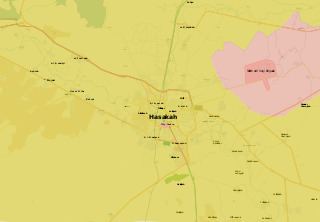 | ||
14 Asayish killed(Kurdish and NDF claim) 77 killed, 170 captured (Kurdish claim) Results Ceasefire; Strategic Kurdish victory Similar Syrian civil war, Eastern al‑Hasakah offensive, 2015 Al‑Hawl offensive, Daraa offensive, Battle of Sarrin (June–Jul | ||
The Battle of al-Hasakah were clashes between the paramilitary police of the Asayish and the People's Protection Units (YPG), against the pro-government National Defence Forces and the Syrian Arab Army, backed by the Syrian Arab Air Force, in the city of al-Hasakah, Syria.
Contents
Background
In 2014 a series of powerful offensives by the Islamic State of Iraq and the Levant brought much of al-Hasakah Governorate under the group's control. Control of Hasakah city itself was split between Kurdish and government forces. On 21 February 2015, the YPG launched an offensive against ISIL, which was followed by a Syrian government offensive on 27 February. The dual offensives saw ISIL pushed back in Hasakah, with the YPG capturing over 100 towns, villages and hamlets and the Syrian Army capturing around 40 villages on Highway 7, which links al-Hasakah to Qamishli. In May 2015, the YPG captured a further 230 towns, villages, and farms west of al-Hasakah during the Western Al-Hasakah Offensive. On 30 May ISIL launched an offensive on al-Hasakah city, but this was repelled. They launched a second offensive on the city on 23 June, initially capturing four districts and areas within three others, as well as multiple villages southwest of Al-Hasakah. However, a YPG counterattack in al-Hasakah with the support of coalition and later backed by the SAA cleared it of ISIL fighters by 1 August, with the YPG left in control of 75% of the city, while the Syrian Army controlled 25%.
The clashes
On 16 August 2016, clashes broke out in Hasakah city between Asayish and NDF forces after a small skirmish, with both sides claiming to have advanced.
On 19 August, al-Masdar News claimed that NDF fighters had advanced in the city center, capturing the New Hospital and parts of the Marsho area. The Syrian Arab Air Force launched 10 airstrikes on the Asayish headquarters. It was the first time during the Syrian civil war when the Syrian Arab Air Force launched airstrikes against the Kurdish forces. According some news agencies, US special forces withdrew around al-Hasakah the same day, though the CJTF–OIR increased their air patrols in the area to prevent the Syrian Air Force from bombing U.S. special forces as well as their Kurdish allies and monitor the situation. Nevertheless, U.S. officials said that they were not trying to establish a no-fly zone. Meanwhile, heavy clashes took place in the Ghwyran area northeast of al-Hasakah and in the al-Nashweh area in the eastern city, where Kurdish forces made major progress according to the Hawar News Agency.
On early 20 August, fighting calmed down, as another attempt to mediate a ceasefire was made. The governor of al-Hasakah, Muhammed Za’al Al-Ali, urged the YPG to stop fighting against the government, as they had fought together against ISIL and had a supportive relationship before the clashes. The PYD accused local NDF troops of spreading anti-Kurdish propaganda and demanded that all NDF units had to leave the city for a new peace agreement, which the government refused. As result, these talks failed, so that heavy clashes once again broke out in the city at noon when the Syrian Airforce started airstrikes with the artillery support of the Syrian Arab Army. After fierce fighting near the Guweiran District to the southwest and in the Nashwa neighborhoods at the city center throughout the night, the violence again abated in course of the following day. Later on 21 August, the newly arrived YPG and MFS forces launched a massive offensive in the city, storming the Red Villas, the Guweiran District, the Al-Askari District, and the eastern Nashwa neighborhoods, resulting in fierce fighting there as government fighters launched counter-attacks to regain these positions. Despite several attempts, government forces failed to regain lost positions. In southern al-Hasakah, the Asayish captured the Faculty of Economics, but reportedly retreated after being shelled by the Syrian Army from the Kawkab Mountains. To support the pro-government fighters, the Syrian Airforce launched over 30 airstrikes on the Kurdish forces in the city. Despite heavy airstrikes and artillery, Kurdish forces captured much of the eastern Guweiran district and were still advancing by the evening. In course of the next night, fighting again stopped. US jets also allegedly began to prevent the Syrian Air Force from striking the Kurds in the city, thus enabling the latter to better advance against government forces.
By dawn on 22 August, however, the Syrian Airforce started its airstrikes again against Asayish checkpoints which led the Asayish storm the northeastern Guweiran District, while NDF units reportedly managed to advance in the Tal Hajjar District in northern and the Al-Zuhour District in southern Al-Hasakah. Fighting was also reported at the al-Basil turning. On the same day, pro-government media al-Masdar News reported that the Kurdish forces were "on the verge of seizing the entire provincial capital", al-Hasakah, after they captured the eastern neighborhoods of the Al-Nashwa District and positions in the Sports City, which served as a major NDF stronghold. Later that day, Kurdish forces captured the central prison and all NDF positions around the Sports City collapsed. At that point, Kurdish forces were in control of about 90% of Hasakah.
On 23 August 2016, a ceasefire agreement was signed after Russian mediation, which left al-Hasakah city almost completely under the control of the Kurdish forces, with all Syrian Armed Forces personnel forced to leave and indefinitely banned from the city. Only the security square which contains the government departments of the city will remain under the protection of civilian government police units.
